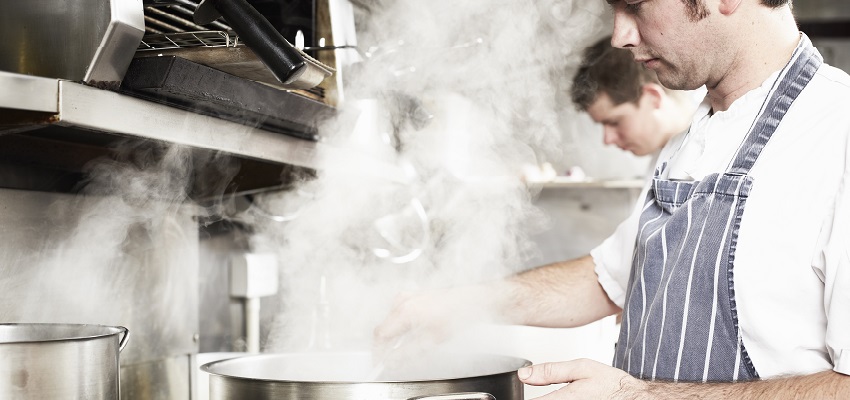What to do when a boil water advisory is issued

If you don’t have safe bottled water, boiling water is the surest method of killing disease-causing organisms, including viruses, bacteria, and parasites.
If you’re hit by a natural disaster or experience a municipal water emergency, you can take steps to prevent illness from contaminated water. In many cases, water can be made safe to use by boiling it.
An alternative for areas without power is water disinfection.
If you don’t have safe bottled water (meaning it hasn’t been exposed to flood water or storm damage), boiling water is the surest method of killing disease-causing organisms, including viruses, bacteria, and parasites.
When health departments issue boil water advisories, foodservice operations can follow these best practices until authorities indicate the advisories are over and the tap water is safe.
First steps to follow
- Post signs or copies of your water system’s health advisory
- Develop a plan to notify and educate employees about emergency procedures
- Shut off appliances that use tap water, such as ice machines, drinking fountains, coffee makers, soda machines and soft drink fountains connected to the water supply
- Discard ice and mixed beverages made with contaminated water
- Use packaged ice from approved sources
- Use bottled or boiled water only for drinking, food prep, washing produce and cooking
- Use disposable plates, cups, lids, and utensils in place of regular tableware
- Be aware and informed of additional requirements issued by your local health department to protect public health during the boil water advisory, such as modifying food prep, suspending certain menu items, or closing the operation
- When boiling water, bring it to a rolling boil for 1 – 3 minutes, depending on elevation. The higher your elevation, the longer you need to boil the water.
Hygiene and cleaning best practices
- Wash hands with water that’s been boiled and cooled, and soap. When done, and as determined by your local health department, use an alcohol-based hand-sanitizer and let hands air dry.
- You can use your commercial dishwashers ONLY IF the water reaches a final rinse temperature of at least 165°F–180°F, as determined by local or state authorities.
- If you can’t use disposable plates, cups, and utensils—and don’t have a dishwasher—wash your dishes by hand using hot water and, in a separate basin, a solution of 1 teaspoon unscented household bleach per gallon of hot water. The label on the bleach needs to show an EPA Registration number and indicate it contains 5% –9 % of sodium hypochlorite. Soak the rinsed dishes in the water/bleach solution for at least a minute, and then let them air dry completely before re-use.
What to do once the advisory is over
Once the advisory is lifted and you’re notified the water supply is usable, take these actions to ensure the safety of your food and beverages:
- Flush the pipes throughout your facility by running each faucet with cold water for at least 15-30 minutes.
- Flush, clean, and sanitize appliances that use tap water, such as beverage dispensers, coffee and tea urns, ice machines, glass washers, and dishwashers. Make sure you follow the manufacturer’s instructions.
- Run water softeners through a regeneration cycle.
- Get your hot water tanks flushed.
- Run your drinking fountains continuously for at least 5 minutes to flush the system.
- Replace and sanitize water filter cartridges according to the manufacturer’s instructions.
- Flush ice machines by following the manufacturer’s instructions. Also take the following steps: Throw out any remaining ice, flush the water line to the machine inlet, close the valve on the water line behind the machine, disconnect the water line from the machine inlet, open the valve and run 5 gallons of water through the valve, dispose of the water, and close the valve.
For detailed information on preparing for, weathering, and recovering from natural disasters or storms, download the National Restaurant Association’s Always Ready: Natural Disasters guide. It also features recommendations on everything from choosing insurance coverages, to preparing your emergency response, and setting up recovery next steps.
A special note
In the wake of Hurricane Ian’s devastation, rebuilding has begun. Restaurants often play unique roles in disaster recovery, providing food, power, and information to those who need it most.
If you are an operator impacted by Ian, there are local resources available to help in your recovery.
The Florida Restaurant and Lodging Association has resources and recovery information for local operators on its website, including The FRLA Disaster Relief Fund, an initiative of the FRLA Educational Foundation.
South Carolina operators impacted by Ian can get the latest recovery information from the state Department of Health and Environmental Control.
Restaurant Disaster Relief Fund
DoorDash, in partnership with Hello Alice, will provide $10,000 relief grants to eligible local restaurants affected by state- or federally-declared natural disasters through the $1M. Restaurant Disaster Relief Fund. If your restaurant is experiencing hardship due to natural disaster, has three stores or less, employs fewer than 50 employees per location, and has revenues of $3M or less per location in the last 12 months, apply today.